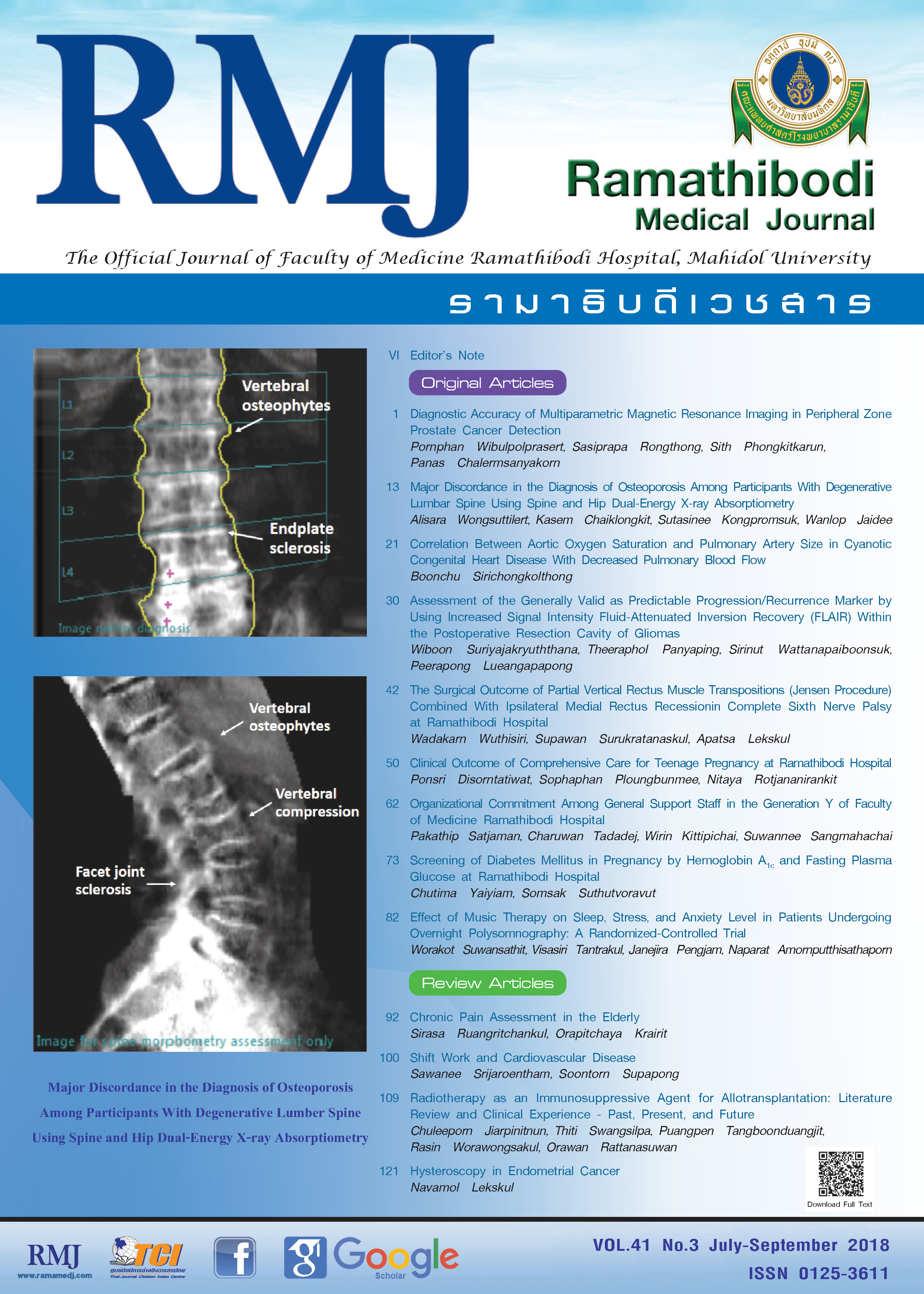Chronic Pain Assessment in the Elderly
Main Article Content
Abstract
Most elderly population suffer from chronic pain which lasts for more than three months. Chronic pain has an effect on physical and psychological status as well as caregivers. Pathophysiology of chronic pain comprises four categories including nociceptive pain, neuropathic pain, mixed pain, and psychological pain. Chronic pain has negative impact on physical health such as tachycardia, hypertension, anorexia, and sleep disturbance; and on psychological health including depression and anxiety. The elderly with chronic pain are evaluated by physicians and nurses in terms of taking histories, physical examination, and applying pain assessment tools to identify severity of pain. Choice of pain assessment tools for older adults is based on individual such as cognitive function and communication skills. However, many physicians cannot precisely evaluate pain among the elderly due to visual, auditory, and cognitive impairment, leading to obstacles in communication and assessment. The best chronic pain assessment tool is multidimensional tool which can accurately identify severity and types of pain. The most common used multidimensional tool in practical is short-form McGill pain questionnaire (SF-MPQ). However, multidimensional tool is only appropriate in the elderly without communication problems and cognitive impairment.
Article Details
References
Loeser JD, Melzack R. Pain: an overview. Lancet. 1999;353(9164):1607-1609. doi:10.1016/S0140-6736(99)01311-2.
Ferrell BA, Ferrell BR, Osterweil D. Pain in the nursing home. J Am Geriatr Soc.1990;38(4):409-414.
AGS Panel on Persistent Pain in Older Persons. The management of persistent pain in older persons. J Am Geriatr Soc. 2002; 50(6 Suppl):S205-S224.
Donald IP, Foy C. A longitudinal study of joint pain in older people. Rheumatology (Oxford). 2004;43(10):1256-1260.
Gibson SJ, Farrell M. A review of age differences in the neurophysiology of nociception and the perceptual experience of pain. Clin J Pain. 2004;20(4):227-239.
The management of chronic pain in older persons. AGS panel on chronic pain in older persons. American Geriatrics Society. Geriatrics. 1998;53(suppl 3):S8-S24.
American Geriatrics Society Panel on Pharmacological Management of Persistent Pain in Older Persons. Pharmacological management of persistent pain in older persons. J Am Geriatr Soc. 2009;57(8):1331-1346.
Gleicher Y, Croxford R, Hochman J, Hawker G. A prospective study of mental health care for comorbid depressed mood in older adults with painful osteoarthritis. BMC Psychiatry. 2011;11:147.
Donohoe CD. History and physical examination of the pain patient. In: Waldman SD, ed. Pain management. 2nd ed. Philadelphia, PA: Elsevier/Saunders; 2011:36-49.
Stolee P, Hillier LM, Esbaugh J, Bol N, McKellar L, Gauthier N. Instruments for the assessment of pain in older persons with cognitive impairment. J Am Geriatr Soc. 2005;53(2):319-326.
Chibnall JT, Tait RC. Pain assessment in cognitively impaired and unimpaired older adults: a comparison of four scales. Pain. 2001;92(1-2):173-186.
Cavalieri TA. Pain management in the elderly. J Am Osteopath Assoc. 2002;102(9):481-485.
Portenoy RK, Tanner RM. Visual Analog Scale and Verbal Pain Intensity Scale. In: Portenoy RK, Tanner RM, eds. Pain Management: Theory and Practice. 5th ed. New York, NY: Oxford University Press; 1996.
Scherder EJ, Bouma A. Visual analogue scales for pain assessment in Alzheimer's disease. Gerontology. 2000;46(1):47-53.
Garra G, Singer AJ, Taira BR, et al. Validation of the Wong-Baker FACES Pain Rating Scale in pediatric emergency department patients. Acad Emerg Med. 2010;17(1):50-54.
Bieri D, Reeve RA, Champion GD, Addicoat L, Ziegler JB. The Faces Pain Scale for the self-assessment of the severity of pain experienced by children: development, initial validation, and preliminary investigation for ratio scale properties. Pain. 1990;41(2):139-150.
Warden V, Hurley AC, Volicer L. Development and psychometric evaluation of the pain assessment in advanced dementia (PAINAD) scale. J Am Med Dir Assoc. 2003;4(1):9-15.
Melzack R. The McGill pain questionnaire: major properties and scoring methods. Pain. 1975;1(3):277-299.
Kitisomprayoonkul W, Klaphajone J, Kovindha A. Thai short-form McGill pain questionnaire. J Thai Rehabil. 2004;14(3):83-92.
Keller S, Bann CM, Dodd SL, Schein J, Mendoza TR, Cleeland CS. Validity of the brief pain inventory for use in documenting the outcomes of patients with noncancer pain. Clin J Pain. 2004;20(5):309-318.




